Pros
Cons
Introduction
Design
Front
{{section_header}}{{section.name}}{{/section_header}}

Back
{{section_header}}{{section.name}}{{/section_header}}

Left
{{section_header}}{{section.name}}{{/section_header}}
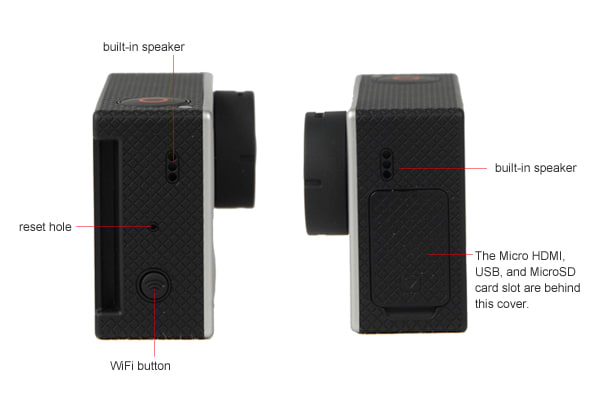
Right
{{section_header}}{{section.name}}{{/section_header}}
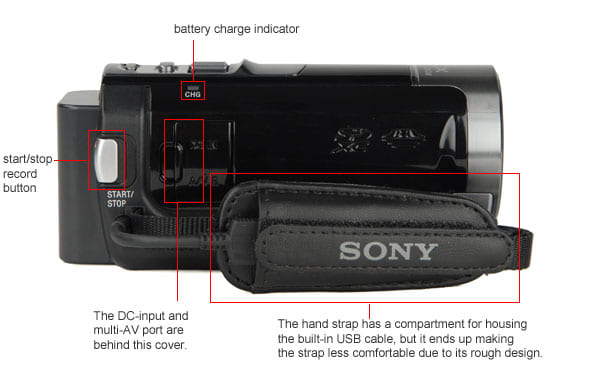
Top
{{section_header}}{{section.name}}{{/section_header}}

Bottom
{{section_header}}{{section.name}}{{/section_header}}

Size & Weight Comparison
{{section_header}}{{section.name}}{{/section_header}}
In the Box
{{section_header}}{{section.name}}{{/section_header}}

Performance
Color
{{section_header}}{{section.name}}{{/section_header}}
The Panasonic HDC-SDT750 produced colors in our bright light test with splendid accuracy and excellent saturation. The camcorder measured a color error of 3.04 and a near-perfect saturation level of 99.23%. These numbers, along with most of the SDT750's numbers in our video testing, are very similar to what we saw on the Panasonic HDC-TM700. More on how we test color.
The HDC-SDT750's Color Error Map (above) shows that the camcorder produced most colors with very good accuracy. Only a few of the red tones on the camcorder were off, and even they were fairly accurate. The camcorder's colors looked vivid and strong, with our only complaint being that certain red images were a bit over saturated.
There aren't any color preset modes on the HDC-SDT750 (except for the soft skin detail mode that smooths skin tones), but the camcorder does have manual color saturation control and a white balance adjustment feature. Examples of these settings are shown above, while the images shown below are comparisons in auto mode.
Even though all of the camcorders in this set did a decent job in our color tests, neither the Sony HDR-CX550V nor the Canon HF S21 could match the color accuracy of the two Panasonic models. All of these camcorders do have some sort of color adjustment controls, however, so you can tweak the colors in ways to suit your liking for these models.
{{comparison_bars title="Color Score Comparison", attribute="Color Score", xLabel="Color Score"}}
Low Light Color
{{section_header}}{{section.name}}{{/section_header}}
Strong low light performance continued for the HDC-SDT750 in our color test, with the camcorder putting up better numbers than the HDC-TM700 and the rest of the high-end models we compared it to. The SDT750 registered a color error of 4.28 and a saturation level of 82.12% in our 60 lux low light test. Of those two scores, the saturation level may be the most impressive, as it is far higher than what we measured from the Canon HF S21 (65.13%) and the Sony HDR-CX550V (60%). The HDC-TM700 managed an equally-strong 81% saturation level in this test. More on how we test low light color.
Overall, there wasn't much of a difference between the HDC-SDT750's and HDC-TM700's low light color performance. Both camcorders did very well and the fact that the SDT750 had a slightly better color accuracy score isn't all that significant (the difference wasn't huge). Panasonic camcorders have done exceptionally well in low light this year and we're pleased to see the HDC-SDT750 continue this trend.
For those that are curious, the HDC-SDT750 put up nearly identical numbers in this test when we shot using its 24p Digital Cinema mode instead of its normal 60i record setting. Also, we should remind you that the camcorder's performance shooting 3D content in low light looked a whole lot worse than its regular recording.
Noise
{{section_header}}{{section.name}}{{/section_header}}
The Panasonic HDC-SDT750 averaged one of the lowest noise levels we've seen in our bright light test. The camcorder registered a noise level of 0.3825% in this test, which is lower than the rest of the camcorders in this set—even though, they also did well on this test. More on how we test noise.
The only camcorder shown above that didn't do exceptionally well on this test is the Canon HF S21, which measured just average noise levels in bright light. Still, when you look at the crops above the images look very good overall. Each of these high-end models captured a sharp, clean image in bright light, but you can see some slight differences when you look closely. For example, the Sony HDR-CX550V's image isn't quite as sharp as the competition (but the difference is very slight).
{{comparison_bars title="Noise Score Comparison", attribute="Noise Score", xLabel="Noise Score"}}
Low Light Sensitivity
{{section_header}}{{section.name}}{{/section_header}}
The HDC-SDT750 required 12 lux of light to reach 50 IRE on our waveform monitor. This is a good score, but it is slightly more light than the Panasonic HDC-TM700 needed for the same test. This small difference between the two models may have to do with some altered processing or slight changes in the lens design of the SDT750 in order to accommodate its 3D capability. More on how we test low light sensitivity.
When shooting 3D with the HDC-SDT750 the camcorder requires a lot more light to record a usable image. The camcorder needed approximately 55 lux of light to reach 50 IRE with its 3D lens attached (that's over four times as much light than the camcorder needed without its 3D lens). Panasonic is honest about this fact, at least, as the SDT750's instruction manual explicitly references the fact that the camcorder needs more light for 3D shooting.
{{comparison_bars title="Low Light Sensitivity Comparison", attribute="Low Light Sensitivity Score", xLabel="Low Light Sensitivity Score"}}
Low Light Noise
{{section_header}}{{section.name}}{{/section_header}}
Continuing its strong overall low light performance, the HDC-SDT750 earned top-notch numbers in our low light noise test. The camcorder averaged 0.68% noise, which is statistically identical to the noise levels we measured on Panasonic's previous top-of-the-line HD camcorder, the HDC-TM700. More importantly, however, this noise percentage is a good deal better than what the Canon HF S21 and Sony HDR-CX550V measured in the same test. More on how we test low light noise.
Looking at the images above, you can actually see the noise on the image produced by the HF S21. The fine specs of noise clutter the vertical trumpets that scale down the left side of the image. You can also see a bit of discoloration and noise on the Sony HDR-CX550V's image, but it isn't as significant. Both Panasonic models offer crisp images in low light, which is why they scored at the top of our low light performance testing.
In defense of Canon, the HF S21 (as well as all Canon models) includes various alternate frame rates that significantly boost low light performance when used. The HDC-SDT70 has one of these alternate frame rates in the form of its 24p Digital Cinema mode. When this mode is used, the camcorder measured even less noise in our low light test (0.5525%), but its performance in our low light color accuracy test showed no improvement.
{{comparison_bars title="Low Light Noise Score Comparison", attribute="Low Light Noise Score", xLabel="Low Light Noise Score"}}
Low Light Color
{{section_header}}{{section.name}}{{/section_header}}
Strong low light performance continued for the HDC-SDT750 in our color test, with the camcorder putting up better numbers than the HDC-TM700 and the rest of the high-end models we compared it to. The SDT750 registered a color error of 4.28 and a saturation level of 82.12% in our 60 lux low light test. Of those two scores, the saturation level may be the most impressive, as it is far higher than what we measured from the Canon HF S21 (65.13%) and the Sony HDR-CX550V (60%). The HDC-TM700 managed an equally-strong 81% saturation level in this test. More on how we test low light color.
Overall, there wasn't much of a difference between the HDC-SDT750's and HDC-TM700's low light color performance. Both camcorders did very well and the fact that the SDT750 had a slightly better color accuracy score isn't all that significant (the difference wasn't huge). Panasonic camcorders have done exceptionally well in low light this year and we're pleased to see the HDC-SDT750 continue this trend.
For those that are curious, the HDC-SDT750 put up nearly identical numbers in this test when we shot using its 24p Digital Cinema mode instead of its normal 60i record setting. Also, we should remind you that the camcorder's performance shooting 3D content in low light looked a whole lot worse than its regular recording.
Motion
{{section_header}}{{section.name}}{{/section_header}}
The Panasonic HDC-SDT750 is one of the best camcorders on the market in terms of motion capturing. The quality of its 1080/60p mode is stunning and the camcorder shows minimal signs of artifacting and blur. There was some trailing with the 60p mode, but overall the camcorder produced impeccable results in our motion test. Even with the SDT750's regular 60i mode things looked fairly good—although it's the 60p mode that puts the camcorder over the top. More on how we test motion.
Video Sharpness
{{section_header}}{{section.name}}{{/section_header}}
Just like the HDC-TM700 before it, the Panasonic HDC-SDT750 did much better on our video sharpness test when we shot using its 1080/60p mode than with its 1080/60i mode. Shooting 60p video, the SDT750 measured a horizontal sharpness of 1000 lw/ph and a vertical sharpness of 900 lw/ph (the same numbers we got from the HDC-TM700). Switching things over to 60i recording, and those numbers drop significantly, down to 900 lw/ph horizontal and 600 lw/ph vertical (which are still very good scores).
We should also note that shooting 3D with the HDC-SDT750 significantly reduces the sharpness level for the recorded image. We don't have the exact numbers, but the camcorder's 3D image is far less sharp than what we saw from the SDT750's regular 60i video. This is especially true when you record moving subjects in 3D. More on how we test video sharpness.
{{comparison_bars title="Video Sharpness Score Comparison", attribute="Video Sharpness Score", xLabel="Video Sharpness Score"}}
Testing Samples
{{section_header}}{{section.name}}{{/section_header}}
Usability
Ease of Use
{{section_header}}{{section.name}}{{/section_header}}
As a 2D camcorder, the HDC-SDT750 is fairly easy to use—really no different than the HDC-TM700 before it. The camcorder has a touchscreen interface, a good instruction manual, and an onscreen tool tip window that provides extra information about menu options. The menu is simple to navigate, but things do get confusing with the multiple menu setups on the camcorder. There's the main menu and there's also the function menu on the bottom of the LCD. Add the lens ring controls to the mix and you've got a bit of a confusing situation, but it isn't too difficult to figure out. We do wish Panasonic would provide better icons (or text) on the function menu, though, as the current icons are often very difficult to figure out.
When shooting 3D content with the camcorder things are actually a lot more difficult. For starters, you must calibrate the 3D conversion lens, which is a process unlike anything else we've seen on a consumer camcorder. Even attaching the conversion lens to the front of the camcorder can be a fairly difficult process due to the small filter thread provided on the front of the HDC-SDT750 (we had to try a few times before it fit snugly).
After attaching the 3D conversion lens, a set of calibration instructions automatically appears on the screen. The instructions provide a good amount of information, and we like their step-by-step nature, but some of the wording (particularly in the final instruction) is a bit confusing. Further instruction and tips on 3D shooting can be found in the camcorder's manual.
Our point is, if you're going to shoot 3D with the SDT750, be prepared to spend some time with the camcorder and figure out how to work its conversion lens and the 3D settings. Many novice camcorder users don't like to see the word "calibration," but you should expect to see it a lot if you plan on shooting in 3D with the HDC-SDT750.
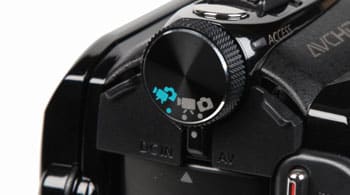
Auto Mode is confusingly called Dual Shot mode
Auto Mode
{{section_header}}{{section.name}}{{/section_header}}
We've written about Panasonic's great auto controls in our previous reviews for the Panasonic HDC-TM700 (read more here) and the HDC-HS60. The HDC-SDT750 has the same automated features as these predecessors, which include its Intelligent Auto (iA) system, AF/AE tracking, face detection, and good autofocus controls. The weakest auto feature on the SDT750 is probably its auto white balance system, but it is also one of the easiest features to set manually (as long as you have a white card you can point the camcorder at before you start shooting).
With the 3D conversion lens attached to the HDC-SDT750 you don't have access to many manual controls. Everything runs in auto mode with the exception of white balance, which can be set manually or you can use one of the camcorder's presets. We found the camcorder to occasionally take a bit more time with its autofocus system when the 3D conversion lens was attached, but it still worked adequately. Auto exposure was also more of a challenge with the conversion lens, but most of that had to do with the fact that the camcorder needs far more light when shooting 3D content instead of 2D.
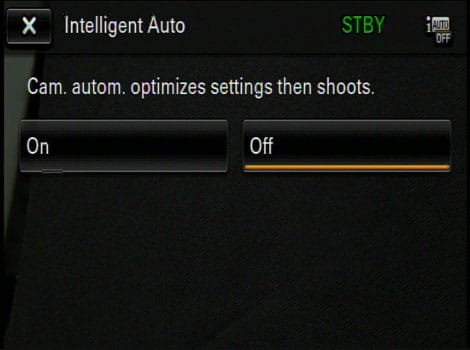
The iAuto mode button is difficult to find, but when you do find it the option for turning on the mode looks like this.
Auto Controls
{{section_header}}{{section.name}}{{/section_header}}
Exposure - We don't like the fact that Panasonic buries the exposure control option on the HDC-SDT750 and the rest of its consumer camcorders. You need to dig through the menu system, find the Picture Adjust submenu, and adjust the "brightness" option in order to do a simple exposure adjustment. We wish this was easier to find and access, but in the meantime you could always just manually set the aperture or shutter speed to adjust exposure levels instead.
Handling
{{section_header}}{{section.name}}{{/section_header}}
As a regular camcorder, the HDC-SDT750 handles in an identical manner to the Panasonic HDC-TM700. The two camcorders have the same dimensions and nearly the same weight (the TM700 is five grams heavier because of its internal memory). They have the same hand straps, the same 3-inch LCD, and the same touchscreen interface. So, if you want to read about how the SDT750 handles as a regular 2D camcorder, check out the handling section of our HDC-TM700 review here.

Attaching the 3D conversion lens to the HDC-SDT750 turns the camcorder into a completely different device. It nearly doubles in size and its weight increases drastically. We also found the camcorder to be a bit heavier up front with the lens attached, which can lead to dipping if your hand gets tired. This is where a better hand strap would come in...err...handy.

Using the 3D conversion lens is the most difficult thing you can do with the HDC-ST750. That doesn't mean it is a huge challenge to figure out, it is just a lot more confusing and awkward than anything else on the camcorder. Screwing in the conversion lens can be annoying (it is difficult to match the screw threads), calibrating the lens is a pain, and using the camcorder to shoot 3D content hand-held is definitely a nuisance. The camcorder has no manual controls when the 3D conversion lens is attached (except white balance), and you cannot even zoom when you shoot 3D content. In short, you are extremely limited as to how you can shoot with the 3D conversion lens attached.

We recommend using a tripod to shoot 3D video with the HDC-SDT750 when possible. The camcorder is easier to use this way, you'll have less trouble calibrating the conversion lens, and your 3D videos will look better. In our testing, we found that 3D content looked incredibly disorienting when we moved the camcorder around a lot and the 3D effect looked far less impressive. The HDC-SDT750 was at its best when we held the camcorder still (or mounted it on a tripod) and shot subjects in 3D that were 4 to 10 feet away from the lens.

These dedicated buttons give you quick access to aperture and shutter speed controls.
Portability
{{section_header}}{{section.name}}{{/section_header}}
Without its 3D conversion lens, the HDC-SDT750 has the same dimensions and is only 5g lighter than the Panasonic HDC-TM700. This makes it one of the most compact high-end camcorders on the market. Of course, this comes at the cost of having a smaller LCD than the competition.
Then there's the case of the 3D conversion lens, which increases the weight of the HDC-SDT750 by roughly 50% and makes the camcorder a whole lot longer. The conversion lens itself has dimensions of 78 x 59 x 97, which is larger than most ultracompact camcorders on their own. Our point is, if you're going to be shooting 3D with the HDC-SDT750 don't expect the camcorder to be all that portable. The conversion lens morphs the camcorder from one of the most compact high-end options, to one of the bulkiest and unbalanced models we've seen.
Battery Life
{{section_header}}{{section.name}}{{/section_header}}
The HDC-SDT750 lasted for 107 minutes in our battery life test, which is identical to the amount of time the Sony HDR-CX550V and Panasonic HDC-TM700 lasted in this same test. The Canon HF S21 was the big loser in this test, lasting close to 30 minutes less than the other three camcorders in this set. More on how we test battery life.
All of these models, the HDC-SDT750 included, have open battery compartments. So, if you'd like to purchase a larger battery that will allow for longer record times, you can easily do so (but those extra batteries can be pricey).

{{comparison_bars title="Battery Life Comparison", attribute="Battery Life Score", xLabel="minutes"}}
LCD & Viewfinder
{{section_header}}{{section.name}}{{/section_header}}
The HDC-SDT750 has the same 3-inch LCD as the Panasonic HDC-TM700 and the HDC-HS700 that came before it. While the 3-inch screen is an improvement over last year's Panasonic camcorders, it is still a good half-inch smaller than what you'll find on the Canon HF S21 and Sony HDR-CX550V (as well as the flagship model from Samsung, the HMX-S16). We'd like to see Panasonic bump up the size of its LCD to 3.5 or 4 inches on its next high-end model.
The SDT750 does have a viewfinder, which is a feature that is often found on flagship models, but is rare to see anywhere else. The viewfinder is small, uncomfortable, and does not angle upwards. It does extend, however, which helps the viewfinder accommodate for larger battery packs that may be loaded beneath it, and it has a diopter adjustment dial.
Stabilization
{{section_header}}{{section.name}}{{/section_header}}
Panasonic camcorders have done a very good job in our stabilization test for the past few years and the HDC-SDT750 kicks things up a notch with its improved Hybrid OIS feature. The camcorder employs an optical image stabilization system with three settings: regular, hybrid, and a powered IS feature that requires you to hold down a button on the LCD to activate. The camcorder did an excellent job in our test with all three settings. More on how we test stabilization.
Before you look at the numbers from our test, keep in mind that the powered IS feature requires you to hold down a button on the LCD during the duration of your recording. For this reason we didn't use the numbers we got from that test because the mere fact that our hands were touching the camcorder while it was on our stabilization rig skewed our results. Still, the numbers do provide you with some good information (and it does more or less reflect real-world use).
In our low shake test, we found the SDT750 to reduce shake by 77% with the camcorder's regular stabilization, 76% with Hybrid OIS, and 85% with the powered IS feature. These numbers are very similar to how the Panasonic HDC-TM700 performed in this test.
With our high shake test we saw a strong improvement on the HDC-SDT750 (compared to previous Panasonic models). The camcorder's regular OIS reduced 85% of the shake, while the Hybrid OIS and powered IS reduced 82% and 83% respectively. What these numbers tell us is that in high shake it really doesn't matter what stabilization feature you use—they are all equally effective (and are all extremely good at reducing shake).
You can use the stabilization feature on the HDC-SDT750 when shooting 3D content with the camcorder. Unfortunately, our testing showed the stabilization system didn't function very well in this setting. It still reduced the shakiness of the image, but it was nothing like what we saw in our test results shown above. Of course, the camcorder is much heavier and weighted far differently when its 3D conversion lens is attached, so those variables had a strong impact on our test.
The clip above shows the HDC-SDT750's stabilization system in action. Watch the video to get a better idea as to how much the camcorder reduced shake during recording.
Manual Focus
{{section_header}}{{section.name}}{{/section_header}}
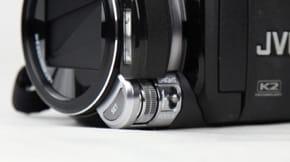
The adjustment dial makes accurate focus adjustments easy.
Manual Exposure
{{section_header}}{{section.name}}{{/section_header}}
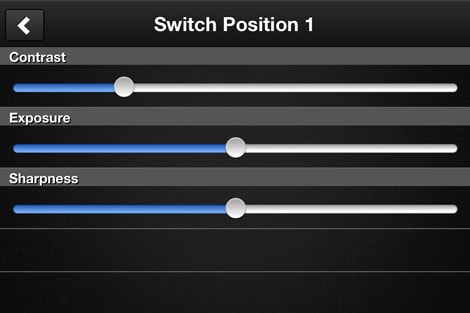
The manual exposure controls are only found on the Contour app, not on the camcorder itself.
Miscellaneous Controls
{{section_header}}{{section.name}}{{/section_header}}
Soft Skin Mode
Softens skin tones, but does so in a subtle manner.
Digital Cinema Color
Allows for recording in the xvYCC expanded color gamut. The enhanced color gamut will only be noticeable on an television that is compatible with xvYCC.
Intelligent Contrast
Corrects exposure levels on images with dark, overexposed, or mixed light portions.
Picture Adjust
This submenu has options for adjusting sharpness, color, brightness (exposure) and WB adjust. The options aren't easily accessible (it is buried in the main menu), but the controls here are useful.
Guide Lines
Displays lines on the screen to assist with framing. The lines can be in the form of three horizontal bars, a 9-sector grid, or a 60-sector grid.
Tele Macro
Lets the camcorder focus on subjects less than 70cm away from the lens.
Zebra Patterns
Displays striped "zebra" patterns on overexposed parts of the image (the patterns are to assist with exposing properly, so they won't end up in your recorded video).
Luminance Meter
A small box appears in the center of the screen that measures the luminance level for that portion of the frame.
Histogram
Displays a histogram chart on the LCD (can be set to always appear or to only appear during iris adjustment).
Auto Controls
{{section_header}}{{section.name}}{{/section_header}}
Exposure - We don't like the fact that Panasonic buries the exposure control option on the HDC-SDT750 and the rest of its consumer camcorders. You need to dig through the menu system, find the Picture Adjust submenu, and adjust the "brightness" option in order to do a simple exposure adjustment. We wish this was easier to find and access, but in the meantime you could always just manually set the aperture or shutter speed to adjust exposure levels instead.
Audio Controls
{{section_header}}{{section.name}}{{/section_header}}
There are a lot of audio features on the HDC-SDT750... but don't get your hopes up, audiophiles. None of the audio features on the SDT750 are all that new, by which we mean all of them were previously found on the HDC-TM700 and the HDC-HS700.
For starters, the HDC-SDT750 has a 5.1-channel Dolby Digital microphone located on the top of the camcorder as well as an external mic and headphone jack on the right side. Depending on how you hold the camcorder, you may have some trouble accidentally rubbing the built-in mic with your fingertips, so be careful.
As for internal settings, you can perform manual audio level adjustments, view audio level displays, adjust bass controls, and turn on an advanced wind cut feature called Wind Noise Canceler. You can also switch the built-in mic over to record 2-channel stereo or turn on its zoom mic feature (which allows the mic to "center-in" on audio coming from a subject the lens is zoomed into).
Editing
{{section_header}}{{section.name}}{{/section_header}}
The Panasonic HDC-SDT750 ships with HD Writer AE version 2.6—the same software that comes with the Panasonic HDC-TM700 (and HDC-HS700). The software enables you to import video, including 1080/60p clips that some editing programs may not be able to handle.
3D clips can be imported using the provided software and the clips are also compatible with most editing programs (any editing program that is compatible with AVCHD). When you import them, however, the clip will display two distorted images side-by-side. When viewed on a 3D TV, these images will overlap to create the 3D effect. For an overview of the software that ships with this and other camcorders, see our article: Video Editing Software For Your Camcorder{{product.brand.name}}-Included-Software.htm.
Features
Compression
{{section_header}}{{section.name}}{{/section_header}}
The Panasonic HDC-SDT750 uses AVCHD compression just like most consumer camcorders that record HD video. However, since AVCHD can't handle 1080/60p, the camcorder also makes use of an "original format" MPEG-4 compression system for recording footage in the 60p mode. This is the same system that was employed on the Panasonic HDC-TM700. Read more about the advantages and disadvantages of AVCHD.
3D files are recorded as regular AVCHD clips on the HDC-SDT750, so there's nothing different about importing them to a computer. If you view the clips on a regular (non-3D) HDTV, though, you'll see two images on the screen split down the middle. This is also what you'll see if you import the 3D clips to an editing program. Read more about the advantages and disadvantages of various high definition compression types.
Media
{{section_header}}{{section.name}}{{/section_header}}
The HDC-SDT750 is a card-only flash memory camcorder, which means it has no internal memory for storing video or photos. Leaving out internal memory helps keep the cost of the SDT750 down, but it also means you must purchase an SD/SDHC/SDXC memory card before you can start recording video with the camcorder. Read more about the advantages and disadvantages of flash memory.
The recording times vary on the HDC-SDT750 depending on what quality setting you use. The 1080/60p mode is the highest quality setting (it records at the highest bitrate), so it allows for the shortest record times. There are other versions of the HDC-SDT750 available in Japan that do include internal memory (like the HDC-TM750), but those models are not available in the US. Read more about the advantages and disadvantages of various media types.

Slow Motion Modes
Still Features
{{section_header}}{{section.name}}{{/section_header}}
The advertised 14.2-megapixel still image capability on the Panasonic HDC-SDT750 is a bit misleading. The camcorder's total pixel count is just 9.15 megapixels, which means that any of its still photo resolution settings that have higher pixel counts than 9.15 megapixels are interpolated. For example, those images—like the camcorder's 4608 x 3072 still image mode—won't have more pixels or detail in their images than the 3600 x 2400 still image option (but they will be physically larger when viewed on a computer).
What this all boils down to is that the Panasonic HDC-SDT750's true maximum native resolution for still images is its 3840 x 2160 size option (captures at a 16:9 aspect ratio). There are plenty of other options on the camcorder that capture still images at a native resolution, but there's also a number of interpolated sizes (everything above 9.15 megapixels). So, does any of this really matter? Not exactly. As long as you take photos with one of the larger settings you should get similar quality out of your still images. Besides, if you're really that concerned about still image quality, you should probably be using a dedicated digital camera instead of a video camcorder to take photos.
The Panasonic HDC-SDT750 did an excellent job in our still color test, producing numbers nearly identical to what we saw from the HDC-TM700. The camcorder managed a color error of just 2.6 with a saturation level of 103%. These values are even better than what the SDT750 registered in our video color accuracy tests (which were also very good).
Noise levels on the HDC-SDT750's still images averaged 0.8%, which is not bad for a camcorder. Again, this noise level is essentially identical to what we measured on the HDC-TM700 (0.81% noise). The Canon and Sony models both had more noise in their still photos.
Still sharpness was something of a disappointment on the HDC-SDT750. The camcorder measured a horizontal sharpness of 1591 lw/ph with 20.7% oversharpening and a vertical sharpness of 895 lw/ph with 19.8% undersharpening. These scores are far lower than what the Canon HF S21 and Sony HDR-CX550V were capable of, which leads us to believe that a single, large image sensor helps produce sharper still images (although the SDT750 schooled the competition in our video sharpness test).
Lens & Imaging System
{{section_header}}{{section.name}}{{/section_header}}

The actual lens on the HDC-SDT750 doesn't appear any different than what Panasonic implemented on the HDC-TM700. It has the same 12x optical zoom and the same aperture and focal range. Panasonic did add two new notches on the front of the lens, though, which allows you to attach the 3D conversion lens (VW-CLT1) to the front of the camcorder.
Adding this conversion lens completely alters the lens specs. It changes the aperture to a fixed f/3.2 (which is why the camcorder needs so much light when recording 3D content), it locks the focal range to 2.5mm, and it eliminates your ability to use the camcorder's optical zoom. The conversion lens also drastically alters the wide angle that the camcorder records video (reducing it by roughly 25°).
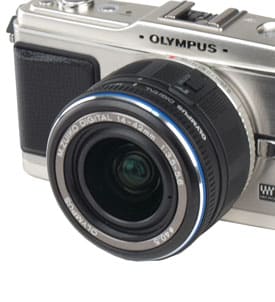
LCD & Viewfinder
{{section_header}}{{section.name}}{{/section_header}}
The HDC-SDT750 has the same 3-inch LCD as the Panasonic HDC-TM700 and the HDC-HS700 that came before it. While the 3-inch screen is an improvement over last year's Panasonic camcorders, it is still a good half-inch smaller than what you'll find on the Canon HF S21 and Sony HDR-CX550V (as well as the flagship model from Samsung, the HMX-S16). We'd like to see Panasonic bump up the size of its LCD to 3.5 or 4 inches on its next high-end model.
The SDT750 does have a viewfinder, which is a feature that is often found on flagship models, but is rare to see anywhere else. The viewfinder is small, uncomfortable, and does not angle upwards. It does extend, however, which helps the viewfinder accommodate for larger battery packs that may be loaded beneath it, and it has a diopter adjustment dial.
Connectivity
{{section_header}}{{section.name}}{{/section_header}}
The HDC-SDT750 has the same connectivity features as the Panasonic HDC-TM700. Inside the camcorder's LCD cavity you'll find a collection of ports covered by a flip-down door. Behind this door is an HDMI terminal, a USB port, an SD/SDHC/SDXC card slot, and a Multi-AV port that supports both AV and Component output.
On the right side of the camcorder, near the front, you'll find an external mic and headphone jack. These ports are fairly well protected by a plastic cover, but the hand strap on the right side does get in their way at times. Behind and above these two ports is another cover that conceals the accessory shoe slot. You cannot insert accessories directly into this slot, but you must instead install the slide-in shoe adapter first (then you can mount accessories to it). We like that this side-mounted slot keeps accessories out of the way from your fingers, but it is also very easy to lose the slide-in adapter... and if that happens you're out of luck until you purchase a new one.
There's one more port on the back of the HDC-SDT750, but you must remove the camcorder's battery in order to find it. When you do so, you'll see a small DC-input port that allows you to run the camcorder off of wall-power. The problem with this setup is that you must remove the battery pack in order to switch power consumption over to the AC adapter. This means if you start a long shot while on battery power, and your battery becomes depleted, you must stop recording in order to switch over to the wall-plug. It may be a minor nuisance, or an issue that isn't very likely to come up, but it is a notable problem nonetheless.
When considering the connectivity features of the HDC-STD750 we must also note the camcorder's 3D conversion lens, although this "feature" should be readily apparent to anyone purchasing the camcorder. The conversion lens mounts to the front of the SDT750 and locks in place by screwing into the filter thread. The conversion lens cannot be connected to previous Panasonic models (like the HDC-TM700) because the regular lens on the STD750 has two connecting slots that allow the 3D lens to fit on its front.
Battery
{{section_header}}{{section.name}}{{/section_header}}
All of these models, the HDC-SDT750 included, have open battery compartments. So, if you'd like to purchase a larger battery that will allow for longer record times, you can easily do so (but those extra batteries can be pricey).

Media
{{section_header}}{{section.name}}{{/section_header}}
The HDC-SDT750 is a card-only flash memory camcorder, which means it has no internal memory for storing video or photos. Leaving out internal memory helps keep the cost of the SDT750 down, but it also means you must purchase an SD/SDHC/SDXC memory card before you can start recording video with the camcorder. Read more about the advantages and disadvantages of flash memory.
The recording times vary on the HDC-SDT750 depending on what quality setting you use. The 1080/60p mode is the highest quality setting (it records at the highest bitrate), so it allows for the shortest record times. There are other versions of the HDC-SDT750 available in Japan that do include internal memory (like the HDC-TM750), but those models are not available in the US. Read more about the advantages and disadvantages of various media types.

3D Lens
{{section_header}}{{section.name}}{{/section_header}}
The ability to record 3D video is obviously the most intriguing and impressive feature of the HDC-SDT750. So, lets get right down to it and talk about the process of recording 3D content with the camcorder.
To begin, we must say that certain 3D videos we recorded with the SDT750 looked very good. If you mount the camcorder to a tripod or keep it very still and shoot subjects that are four to ten feet away, you will get some 3D content that is crisp and strong. 3D images popped very well in this manner, although we didn't get the effect of subjects "jumping" out from the screen that you sometimes see with 3D movies. The videos looked more like a funky diorama where you can see layers and the shape of the subjects within the frame. It is interesting and effective, but it may not be quite what you expect when you hear "3D capability."

We found that doing hand held shots in 3D produced undesirable results. The quick motion of the camcorder produced blurry, disorienting 3D content that gave us a headache more than anything else. Keeping the camcorder still is key to producing quality 3D content. It doesn't matter if your subject is moving at a rapid pace—our motion test looked great in 3D—but things came out best when our camcorder was kept perfectly still on a tripod.

You also need to make sure you have plenty of light when you shoot 3D video with the camcorder. Since you cannot adjust aperture or shutter speed manually, you'll need to rely on the camcorder's automatic controls to get the image you want (you also cannot focus manually). There is an auto slow shutter feature for shooting 3D and you may want to turn it on if you're capturing video in a low light situation. Still, we found low light images looked terrible in 3D, so our overall recommendation is to shoot outside where there is a lot of sunshine, or indoors with very bright light.


Calibrating the 3D conversion lens is strange and can be confusing, but Panasonic does provide good instructions (both onscreen and in the manual) on the matter. You don't have to calibrate the 3D lens every time you connect it to the camcorder, but it is a good idea to go through the calibration process so you can make sure nothing has changed dramatically (especially if it has been a while since your last calibration). The menu grabs below show the calibration process on the camcorder. There are 8 pages of instructions in all and Panasonic lists the instructions in a step-by-step manner.

The 3D conversion lens does not work with other Panasonic camcorders due to a slight alteration of the lens design and some internal processing that is present on the HDC-SDT750 (and isn't found on the HDC-TM700 or other Panasonic models). Once you connect the conversion lens to the SDT750 correctly, the camcorder will automatically recognize that the conversion lens is connected and it wcontentill begin the calibration process (if you haven't calibrated things in a while).

Videos displayed on the SDT750's LCD will not appear in 3D, but if you output the video to a 3D capable HDTV the clips should look fine. If you watch 3D content on a regular television, you'll see a split-screen of two identical videos with squished aspect ratios. We watched the 3D content on the Panasonic TC-P42GT25 HDTV and the television automatically detected the SDT750's 3D videos as being 3D (and displayed them as such).
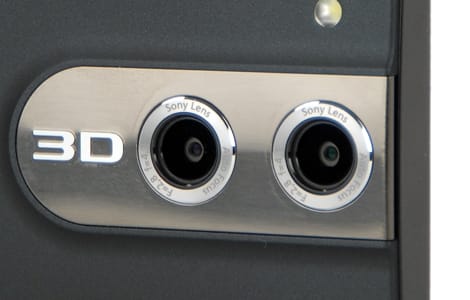
The second built-in lens is what lets you record video in 3D—without any tricky calibration.
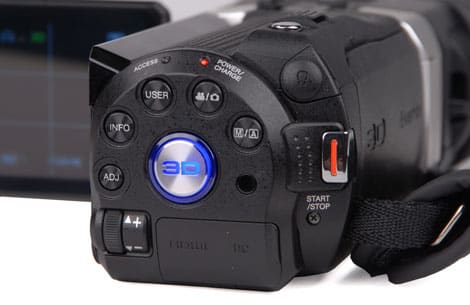
You can adjust a variety of controls—including zoom and focus—in 3D record mode.
3D Playback
Still Features
{{section_header}}{{section.name}}{{/section_header}}
The advertised 14.2-megapixel still image capability on the Panasonic HDC-SDT750 is a bit misleading. The camcorder's total pixel count is just 9.15 megapixels, which means that any of its still photo resolution settings that have higher pixel counts than 9.15 megapixels are interpolated. For example, those images—like the camcorder's 4608 x 3072 still image mode—won't have more pixels or detail in their images than the 3600 x 2400 still image option (but they will be physically larger when viewed on a computer).
What this all boils down to is that the Panasonic HDC-SDT750's true maximum native resolution for still images is its 3840 x 2160 size option (captures at a 16:9 aspect ratio). There are plenty of other options on the camcorder that capture still images at a native resolution, but there's also a number of interpolated sizes (everything above 9.15 megapixels). So, does any of this really matter? Not exactly. As long as you take photos with one of the larger settings you should get similar quality out of your still images. Besides, if you're really that concerned about still image quality, you should probably be using a dedicated digital camera instead of a video camcorder to take photos.
The Panasonic HDC-SDT750 did an excellent job in our still color test, producing numbers nearly identical to what we saw from the HDC-TM700. The camcorder managed a color error of just 2.6 with a saturation level of 103%. These values are even better than what the SDT750 registered in our video color accuracy tests (which were also very good).
Noise levels on the HDC-SDT750's still images averaged 0.8%, which is not bad for a camcorder. Again, this noise level is essentially identical to what we measured on the HDC-TM700 (0.81% noise). The Canon and Sony models both had more noise in their still photos.
Still sharpness was something of a disappointment on the HDC-SDT750. The camcorder measured a horizontal sharpness of 1591 lw/ph with 20.7% oversharpening and a vertical sharpness of 895 lw/ph with 19.8% undersharpening. These scores are far lower than what the Canon HF S21 and Sony HDR-CX550V were capable of, which leads us to believe that a single, large image sensor helps produce sharper still images (although the SDT750 schooled the competition in our video sharpness test).
Other Features
{{section_header}}{{section.name}}{{/section_header}}
Pre Record
A common feature on consumer camcorders, Pre Record lets you capture a few seconds of footage before you press the record button. This footage is stored in a continual buffer, but it only saves the few seconds of video it captures before you start actual recording. Can be very useful for shooting action sequences or sports.
Auto Ground Standby (AGS)
AGS isn't the most useful feature, but it can be helpful for people who have a difficult time remembering to hit the record button when the want to stop recording. With AGS activated, the camcorder will automatically stop recording if it detects the lens as being pointed towards the ground for a period of time. Again, this can be useful, but it can also be an unwanted nuisance if, say, you actually want to film something on the ground.
Fader
An option on the function menu, fader allows you to add faders to your video clips (at the beginning or end).
Time Lapse Record
To capture motion over a long period of time (like a flower blooming) you can use Time Lapse Record. You select a recording interval from 1, 10, 30, 60, or 120 seconds, and the camcorder will capture one frame of video at each of those intervals.
Sony HDR-CX550V Comparison
The Canon HF S21 and the Panasonic HDC-SDT750 retail for the same price (around $1400), but they have wildly different features and benefits. Where the HDC-SDT750 makes a splash is with its 3D capability and 1080/60p recording mode. The Canon HF S21, on the other hand, offers a more professional design, a native 1080/24p record mode, 64GB of internal flash memory, and two memory card slots.
So, which model gets you more bang for the buck? Unless you have a strong desire to shoot 3D video, the answer is probably the Canon HF S21. Of course, if you don't care about 3D content, you probably shouldn't be looking at the SDT750 in the first place (the Panasonic HDC-TM700 is a much better deal). The Canon HF S21 is the only consumer camcorder to offer a native 24p mode and it is also loaded with a PF30 and PF24 option as well.
With its abundance of internal memory, the Canon HF S21 is ready to go right out of the box, while you'll have to purchase an additional SDHC memory card if you want to use the Panasonic HDC-SDT750. Basically, what we're saying is that the price of the Panasonic is inflated here—and that high price is entirely a result of the novelty of 3D recording. The Canon HF S21 is pricey too, though, so you may be better off checking out some of the cheaper options out there.
Panasonic HDC-TM700 Comparison
Sony's flagship model for 2010, the HDR-CX550V, is a solid camcorder that is easy to use, but it lacks a few of the manual controls that you find on high-end models from Panasonic and Canon. The CX550V is cheaper than the HDC-SDT750, but its price tag is still a lot higher than that of the Panasonic HDC-TM700 and JVC GZ-HM1 (both of which are very good, high-end camcorders).
Is there a compelling reason to go with the HDR-CX550V? Well, it does have one of the better auto modes on the market, so it is good for beginners, and it is one of the few HD camcorders that also has the capability of recording standard definition video (a feature that is found on most Sony models). This ability to record SD video is probably the best thing about the Sony HDR-CX550V, and it makes the camcorder an excellent "bridge" model for those who are slowly making the switch over to HD.
The Sony does not have a 24p or 60p record mode—all of its video is captured at 1080/60i (except for the SD record modes). The camcorder does have a limited slow motion mode as well, but its quality is poor and the controls are very limited. And, although it should be obvious to most readers, the Sony HDR-CX550V cannot record 3D video. If that is the feature you're looking for, you really only have one choice at this point: the Panasonic HDC-SDT750.
As a 2D camcorder, the Panasonic HDC-SDT750 is better than the HDR-CX550V, but their difference isn't huge. The fact that the HDR-CX550V is $200 less makes it the better buy, even though the SDT750 did better in a number of our tests (and it has more manual controls). Remember, though, this is just 2D videography we're talking about.
COMP 3
Remove the 3D conversion lens from the HDC-SDT750 and we challenge you to find a significant difference between it and the Panasonic HDC-TM700. There really isn't much of any on the outside (except for a slight lens alteration to accommodate the fitting of the conversion lens), and on the inside the only difference is a new stabilization option and the lack of any internal memory on the SDT750.
In comparing these to models, we must reiterate what we've said throughout this review: if you have no use for recording 3D, the Panasonic HDC-TM700 is a far better deal than the HDC-SDT750. Comparing the list price of the two camcorders, you'll see that the TM700 is $400 cheaper than the SDT750—and the TM700 contains 32GB of internal memory compared to the SDT750's zero. This means, not taking into account the cost of memory, you're paying $400 for the 3D conversion lens on the SDT750. If that seems like a worthy expense to you, then you should splurge for the HDC-SDT750 by all means. Recording 3D is fun, it's unique, and the HDC-SDT750 is the only consumer camcorder out there that is offering it as an option. Plus, you're getting an amazing camcorder for 2D recording as well.
But, if all you want to do is record your life in old-fashioned 2D, then you should save yourself lots of money and buy the HDC-TM700 instead. The camcorder lists for $999, but it can be found for as little as $799 on the web. Recently, we even saw the TM700 listed for $599 on Panasonic's own website. Simply put, that's probably the best camcorder bargain we've ever seen. At this rate, Panasonic may be giving the HDC-TM700 away by the time Black Friday rolls around. Keep your eyes peeled.
Conclusion
The HDC-SDT750 ($1399 MSRP) is an extraordinary camcorder for capturing regular 2D content, but its 3D features are definitely limited. Performance-wise, we were definitely impressed with how well the camcorder recorded footage in 3D, but we were consistently disappointed by the lack of manual controls in 3D mode. You cannot use zoom, manual focus, manual shutter speed, or manual aperture while the 3D conversion lens is attached.
We also wonder how many people will really be able to take full advantage of the HDC-SDT750's 3D features. For starters, you'll need a 3D HDTV so you can view your recorded content. You'll also need time and patience because shooting 3D video with the HDC-SDT750 isn't nearly as simple as picking up the camcorder to shoot regular 2D video. 3D content shot with the SDT750 can look very good and effective, but we found the camcorder worked best when it was kept perfectly still or mounted to a tripod (you also need plenty of light to get top-notch 3D images).
For recording 2D video, the HDC-SDT750 is one of the best camcorder's we've ever seen. Of course, the model really isn't any different than its predecessor, the Panasonic HDC-TM700. If you have no desire to record 3D video, by all means you should seek the TM700 instead of the SDT750. We say this for one reason—price. The HDC-TM700 can be found for anywhere between $400 - $700 less than the HDC-SDT750, and it is basically the same exact camcorder except it cannot shoot in 3D. An added bonus of the HDC-TM700 is the fact that it comes with 32GB of internal flash memory, while the HDC-SDT750 only records to memory cards.
We're a bit disappointed that Panasonic hasn't released the 3D conversion lens (model name VW-CLT1) on its own. It is clear that Panasonic is trying to cash in on the novelty of 3D recording by jacking up the price of the HDC-SDT750 well beyond the cost of the HDC-TM700. So, if you are considering the HDC-SDT750 you really have to think about how much 3D recording is worth. If it isn't something you desperately want or seriously need, then you should save yourself oodles of cash and purchase the HDC-TM700 instead.
Photo Gallery
{{photo_gallery "Front Photo", "Left Photo", "Left Open Photo", "Back Photo", "Right Photo", "Top Photo", "Bottom Photo", "Lens Photo", "Lens Photo 2", "3D Lens Photo", "Media Photo", "Easy Mode Photo", "Manual Controls Photo", "Zoom Photo", "Zoom Photo 2", "Ease of Use Photo", "Battery Photo", "LCD Photo 1", "LCD Photo 2", "EVF Photo 1", "EVF Photo 2", "Mic Photo", "Mic Photo 2", "Ports Photo 1", "Ports Photo 2", "Ports Photo 3", "Ports Photo 4", "Ports Photo 5", "Ports Photo 6", "Handling Photo 1", "Handling Photo 2", "Handling Photo 3", "Handling Photo 4", "Box Photo"}}
Meet the tester
Jeremy is the video expert of our imaging team and Reviewed.com's head of video production. Originally from Pennsylvania and upstate NY, he graduated from Bard college with a degree in film and electronic media. He has been living and working in New England since 2005.
Checking our work.
Our team is here to help you buy the best stuff and love what you own. Our writers, editors, and experts obsess over the products we cover to make sure you're confident and satisfied. Have a different opinion about something we recommend? Email us and we'll compare notes.
Shoot us an email